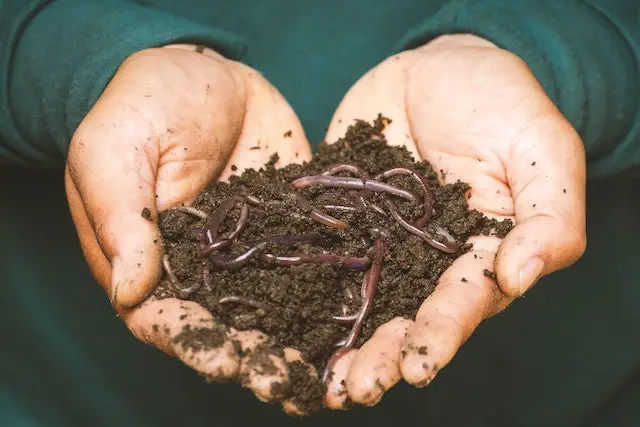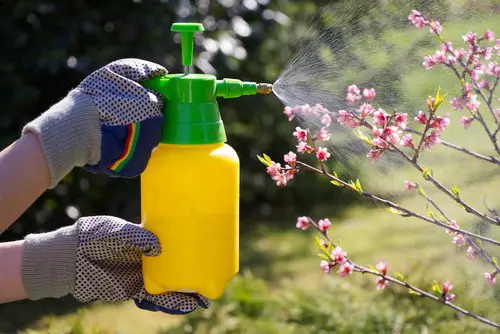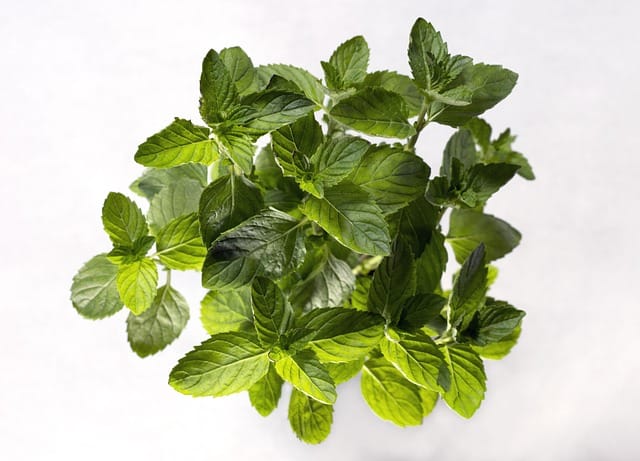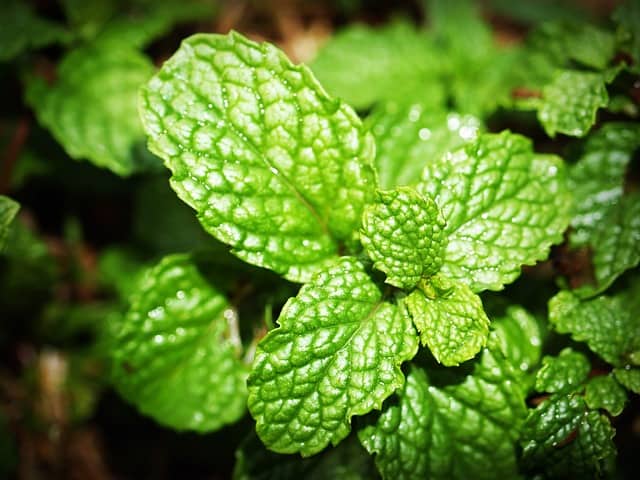Mint leaves are a popular herb used in various dishes and beverages. However, sometimes white spots can appear on the leaves, ruining their fresh appearance and possibly indicating an underlying issue.
Identifying the cause of white spots on mint leaves is crucial for maintaining the health of the plant and preventing further damage.
White spots on mint leaves can be caused by a variety of factors, including pest infestations, fungal infections, and nutrient deficiencies. It is important to identify the underlying cause of the white spots before attempting any treatment methods.
In some cases, the white spots may be harmless and merely a cosmetic issue. However, in other cases, they can be a sign of a more serious problem that needs to be addressed promptly.
Key Takeaways
- White spots on mint leaves can indicate a variety of issues, including pest infestations, fungal infections, and nutrient deficiencies.
- Identifying the underlying cause of the white spots is crucial for determining the appropriate treatment method.
- Preventive measures, such as proper watering and fertilization, can help maintain the health of mint plants and prevent the development of white spots.
More on this category:
Identifying White Spots on Mint Leaves

Mint plants are known for their refreshing aroma and taste. However, sometimes white spots can appear on mint leaves, which can be a sign of a problem. Identifying the cause of white spots on mint leaves is crucial to prevent further damage to the plant and ensure its health.
There are several possible causes of white spots on mint leaves, including environmental factors, pest infestations, and diseases. Here are some ways to identify the cause of white spots on mint leaves:
- Environmental factors: Dust on the leaves, hard water, and improper nutrition can cause white spots on mint leaves. If the white spots are only on the surface of the leaves and do not affect the plant’s health, it is likely due to environmental factors.
- Pest infestations: Spider mites and thrips are two common pests that can cause white spots on mint leaves. Thrips cause metallic bronze or silver spots on the edges of the leaves, while spider mites create webbing and tiny white spots on the leaves.
- Diseases: Fungal and viral diseases can also cause white spots on mint leaves. Powdery mildew is a common fungal disease that creates a white, powdery substance on the leaves. Mosaic virus causes irregular white spots on the leaves and can stunt the plant’s growth.
To identify the cause of white spots on mint leaves, it is important to examine the leaves closely and look for any other symptoms. If the white spots are due to pest infestations or diseases, it is important to take action quickly to prevent further damage to the plant.
Mint Leaves Have White Spots – 4 Common Problems
Mint plants are known for their refreshing fragrance and taste. However, white spots on mint leaves can be a sign of underlying problems. In this section, we will discuss some common causes of white spots on mint leaves.
1. Powdery Mildew
Powdery mildew is a fungal disease that can cause white spots on mint leaves. It appears as a white, powdery substance on the upper surface of the leaves. The disease is caused by a group of fungi that thrive in warm and humid conditions. Powdery mildew can spread quickly, especially in crowded and damp environments.
To prevent powdery mildew, it is important to keep the mint plant dry and well-ventilated. Avoid watering the plant from above, as this can create a moist environment that is ideal for the fungus to grow. Instead, water the plant at the base, and make sure the soil is well-drained.
2. Pest Infestation
Pests such as thrips, spider mites, whiteflies, and mealybugs can also cause white spots on mint leaves. These insects feed on the sap of the plant, which can cause damage to the leaves and stems. The damage appears as white spots or stippling on the leaves.
To control pest infestations, it is important to identify the type of pest and take appropriate measures. For example, you can use insecticidal soap or neem oil to control spider mites and whiteflies. For mealybugs, you can use rubbing alcohol to remove the insects from the plant.
3. Nutrient Deficiency

Nutrient deficiency can also cause white spots on mint leaves. Lack of nutrients such as nitrogen, phosphorus, and potassium can cause the leaves to turn yellow or develop white spots. In addition, hard water can also cause nutrient deficiencies in the plant.
To prevent nutrient deficiency, it is important to fertilize the plant regularly with a balanced fertilizer. You can also use a water filter to remove impurities from the water and prevent nutrient deficiencies.
4. Viral Diseases
Viral diseases such as mosaic viruses can also cause white spots on mint leaves. These diseases are caused by viruses that infect the plant and cause damage to the leaves. The damage appears as white spots or streaks on the leaves.
To prevent viral diseases, it is important to remove infected plants from the garden and avoid planting new plants in the same location. You can also use virus-free seeds and plants to reduce the risk of infection.
Treatment Methods
Mint leaves with white spots can be treated with various methods. Here are a few effective treatment methods:
1. Using Neem Oil
Neem oil is a natural pesticide that can be used to treat white spots on mint leaves. It is effective against a wide range of pests and can be easily found in gardening stores.
To use neem oil, mix it with water as per the instructions on the label and spray it on the affected mint leaves. Repeat the process every few days until the white spots disappear.
2. Applying Baking Soda
Baking soda is another natural remedy that can be used to treat white spots on mint leaves. It has antifungal properties that can help get rid of the fungus causing the white spots.
To use baking soda, mix 1 tablespoon of baking soda with 1 quart of water and spray it on the affected mint leaves. Repeat the process every few days until the white spots disappear.
3. Utilizing Commercial Fungicide

Commercial fungicides are chemical solutions that can be used to treat white spots on mint leaves. They are effective against a wide range of fungal diseases and can be easily found in gardening stores.
To use a commercial fungicide, mix it with water as per the instructions on the label and spray it on the affected mint leaves. Repeat the process every few days until the white spots disappear.
It is important to note that while these treatment methods are effective, it is also essential to prevent the recurrence of white spots on mint leaves. This can be done by ensuring that the mint plant is grown in well-draining soil, not overwatering the plant, and providing adequate sunlight.
Preventive Measures
Mint leaves with white spots can be prevented by following some simple steps. Proper watering, appropriate sunlight, and regular dusting are some of the measures that can help keep mint leaves healthy.
1. Proper Watering
Mint plants require proper watering to thrive. Overwatering or underwatering can lead to white spots on the leaves. It is essential to water the mint plant when the topsoil is dry to the touch.
One way to check the moisture level of the soil is to stick a finger into the soil up to the first knuckle. If the soil feels dry, it is time to water the plant. However, if the soil feels wet, wait for a few more days before watering.
2. Regular Dusting
Dust can accumulate on the leaves of the mint plant, leading to white spots. It is essential to dust the leaves regularly to prevent this. One way to do this is to use a soft-bristled brush or a damp cloth to wipe the leaves. It is essential to be gentle while dusting to avoid damaging the leaves.
In addition to these measures, it is also essential to use the right pot, soil, and fertilizer for the mint plant. The pot should be big enough to allow the roots to spread, and the soil should be well-draining. It is also important to use a fertilizer that is specifically designed for mint plants.
Furthermore, it is important to keep the mint plant away from dry and warm areas. Dry air can cause the leaves to turn white, and warm temperatures can cause the soil to dry out quickly. It is also important to avoid using hard water to water the mint plant, as this can cause mineral buildup in the soil.
By following these preventive measures, it is possible to keep mint leaves healthy and free from white spots.
3. Appropriate Sunlight

Mint plants require adequate sunlight to grow and thrive. However, too much direct sunlight can cause the leaves to turn white. It is essential to place the mint plant in a spot that receives partial sunlight. If the plant is placed in a location that receives too much direct sunlight, it is essential to move it to a spot that receives partial sunlight.
Health Benefits of Mint Leaves
Mint leaves are not only delicious but also packed with numerous health benefits. They are a rich source of vitamins and minerals, including vitamin C, calcium, and magnesium. Here are some of the health benefits of mint leaves:
1. Digestive Health
Mint leaves are known for their ability to soothe upset stomachs. They contain compounds that can help relax the muscles in the digestive tract, which can relieve symptoms of indigestion, bloating, and gas. Mint leaves can also promote the production of bile, which helps to break down fats in the digestive system.
2. Respiratory Health
Mint leaves can help alleviate respiratory issues such as coughs, colds, and allergies. They contain menthol, which has a cooling effect on the throat and nasal passages, making it easier to breathe. Menthol can also help to clear mucus from the airways, which can reduce congestion.
3. Oral Health
Mint leaves can freshen breath and promote oral health. They contain antibacterial properties that can help to kill harmful bacteria in the mouth, which can cause bad breath and tooth decay. Mint leaves can also reduce inflammation in the gums, which can help to prevent gum disease.
4. Skin Health
Mint leaves contain antioxidants that can help to protect the skin from damage caused by free radicals. They can also help to reduce inflammation and irritation on the skin, making them a great natural remedy for conditions such as acne and eczema.
Conclusion

One common cause of white spots on mint leaves is powdery mildew. This fungal disease can be identified by the powdery white substance that appears on the leaves. To prevent powdery mildew, it is important to provide proper air circulation and avoid overwatering.
Another potential cause of white spots on mint leaves is hard water and dust buildup. Hard water can leave mineral deposits on the leaves, while dust buildup can block sunlight and hinder photosynthesis. Regularly cleaning the leaves and using filtered water can help prevent these issues.
It is also important to note that white spots on mint leaves can be a sign of a magnesium deficiency. If this is the case, adding magnesium to the soil can help prevent further damage to the plant.
Frequently Asked Questions
How to get rid of white spots on mint leaves?
To get rid of white spots on mint leaves, you can use a solution of water and dish soap. Mix one tablespoon of dish soap with one quart of water and spray the solution on the affected leaves.
Alternatively, you can use a solution of baking soda and water. Mix one tablespoon of baking soda with one quart of water and spray the solution on the affected leaves. Repeat the treatment every seven to ten days until the white spots disappear.
How to treat fungus on mint plant?
To treat fungus on a mint plant, you can use a fungicide spray. Look for a fungicide that is labeled for use on mint plants and follow the instructions on the label.
Alternatively, you can use a solution of neem oil and water. Mix one tablespoon of neem oil with one quart of water and spray the solution on the affected leaves. Repeat the treatment every seven to ten days until the fungus disappears.
What is the white mold on mint leaves?
The white mold on mint leaves is a fungal disease called powdery mildew. It appears as a white, powdery substance on the surface of the leaves.
Powdery mildew is caused by a fungus that thrives in warm, humid environments. It can spread quickly and cause damage to the plant if left untreated.
What are the spots on mint leaves?
The spots on mint leaves can be caused by a variety of factors, including fungal diseases, pest infestations, salt buildup, nutrient deficiencies, leaf sunscald, or lack of water. It is important to identify the cause of the spots in order to treat the problem effectively.
How do you get rid of fungus on mint leaves?
To get rid of fungus on mint leaves, you can use a fungicide spray or a solution of neem oil and water.
Follow the instructions on the label of the fungicide spray or mix one tablespoon of neem oil with one quart of water and spray the solution on the affected leaves. Repeat the treatment every seven to ten days until the fungus disappears.
Why are my mint leaves turning white?
Mint leaves can turn white due to a fungal disease called powdery mildew, pest infestations, salt buildup, nutrient deficiencies, leaf sunscald, or lack of water. It is important to identify the cause of the problem in order to treat it effectively.

Hey, I’m Lisa and I’ve been an avid gardener for over 30 years. I love writing, talking and living in the garden! Feel free to connect with me on my socials below

